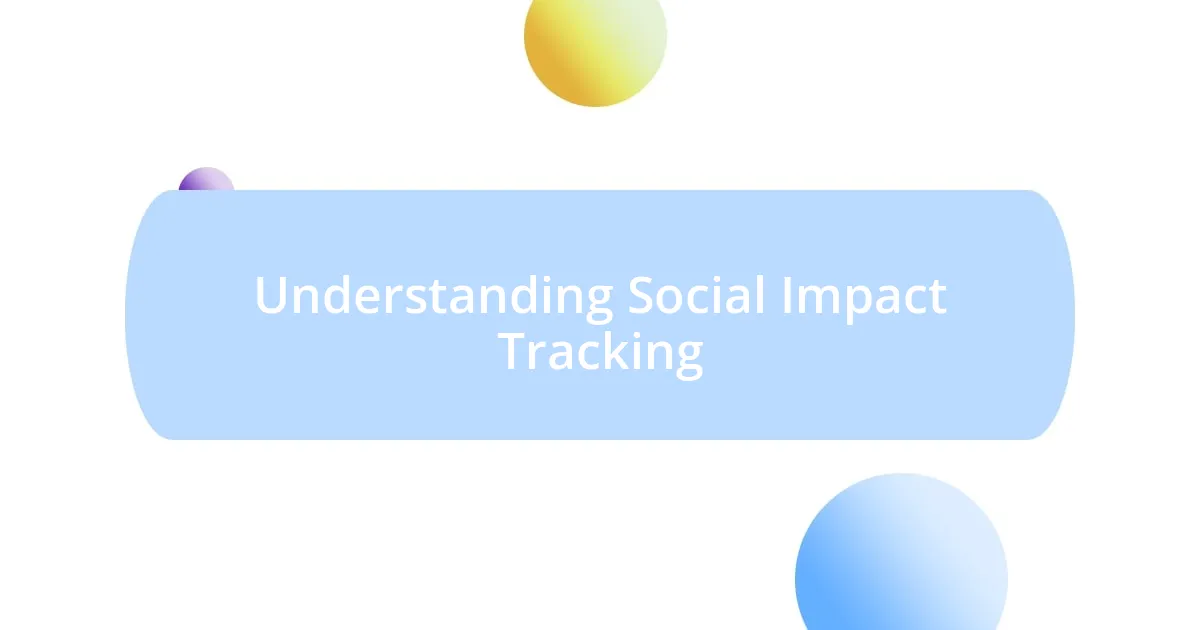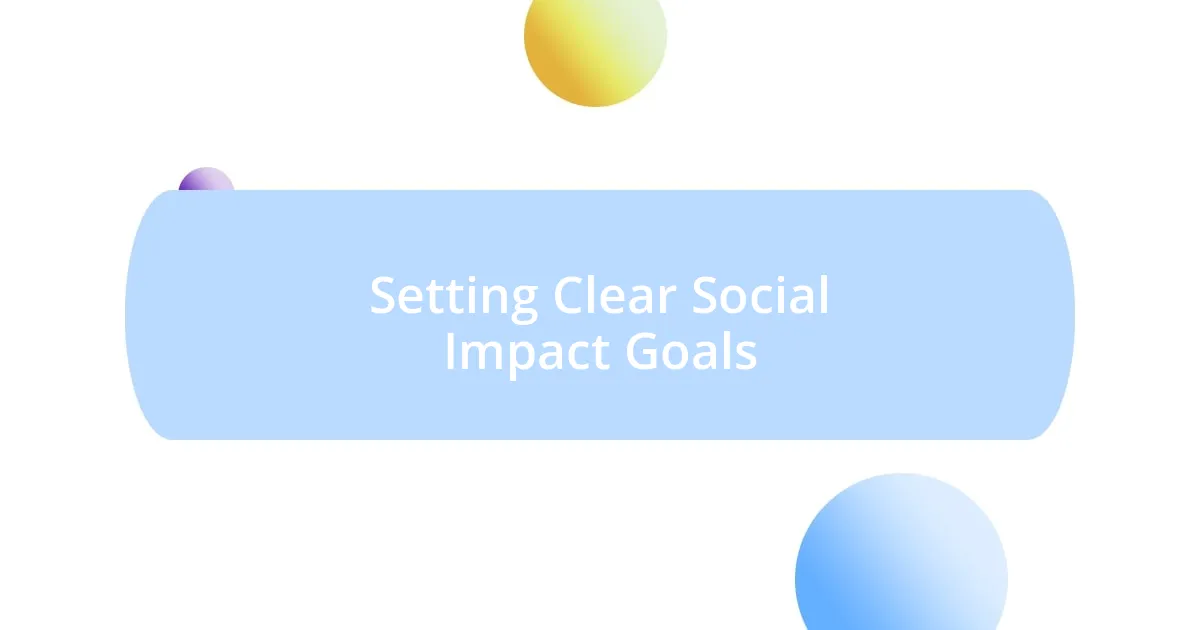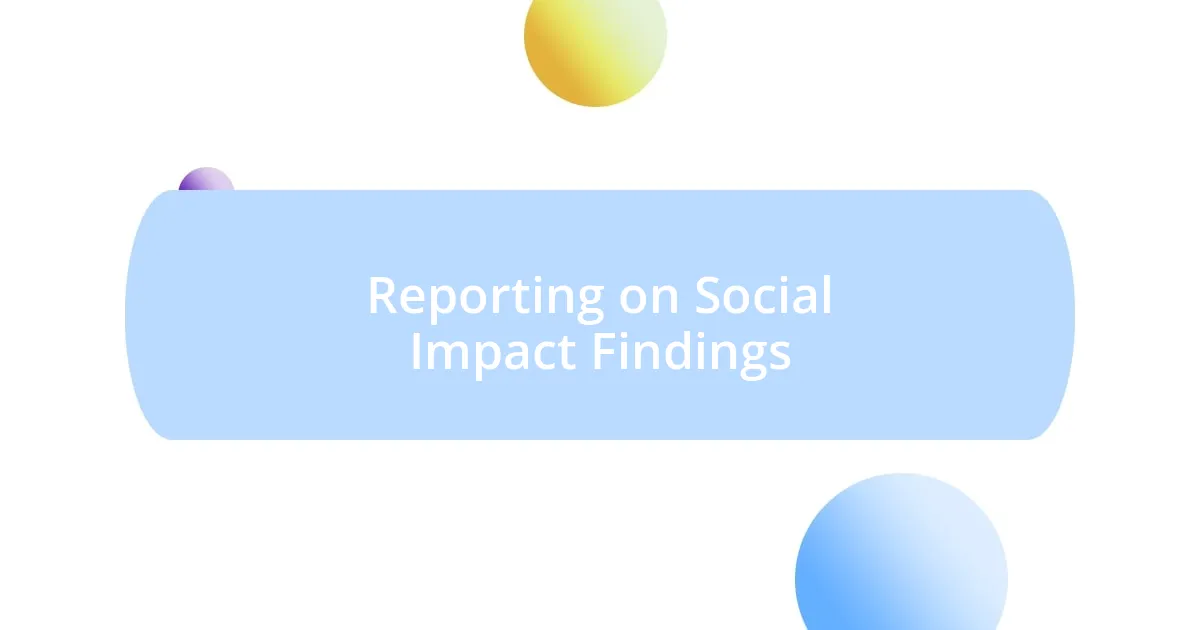Key takeaways:
- Effective social impact tracking combines quantitative metrics with qualitative narratives to reveal deeper insights into community experiences.
- Engaging community members in goal-setting and data collection fosters ownership and enhances commitment to social initiatives.
- Visual storytelling in reporting can amplify data impact, making it more relatable and compelling for stakeholders.
- Continuous feedback loops and flexible goal adjustment are essential for adapting to evolving community needs and ensuring accountability.

Understanding Social Impact Tracking
Understanding social impact tracking isn’t just about collecting data; it’s about uncovering stories that illustrate real change. I remember a project where we monitored community health outcomes. Instead of just numbers, we found powerful testimonials from families whose lives were transformed—those stories made the data come alive.
To me, effective tracking means establishing metrics that genuinely reflect the values of the community we’re serving. Have you ever considered how a single statistic might overshadow the nuances of individual experiences? I once faced this dilemma when we focused solely on employment rates, neglecting to capture the joy and pride of those newly employed. That’s when I learned that qualitative data can be just as crucial as quantitative figures in painting a complete picture.
Moreover, it’s essential to adapt tracking methods to the specific context of our initiatives. For instance, I’ve seen organizations that rigidly stick to predetermined indicators, missing out on valuable insights. When I diversified our tracking approach to include feedback loops, we started to see emerging trends in community needs that we had previously overlooked. This flexibility helped us stay responsive and truly impactful.

Importance of Social Impact Measurement
Measuring social impact is crucial for understanding the effectiveness of our initiatives. From my perspective, these metrics provide a roadmap that guides decision-making. For instance, during a literacy program I helped implement, tracking not just test scores but also participants’ confidence levels revealed a deeper story about their growth. These insights underscored the importance of measuring progress in a holistic way—allowing us to adjust our approach to better meet learners’ needs.
In my experiences, gaining stakeholder buy-in is easier when we have clear evidence of impact. By presenting measurable outcomes, I found it much simpler to communicate the value of our work to potential funders and community leaders. A memorable moment was when I shared the stories of participants whose lives had dramatically changed, backed by data showcasing increased literacy rates. This blend of quantitative and qualitative evidence fostered trust and strengthened our partnerships.
Additionally, understanding social impact helps ensure accountability. I recall one project where we tracked community engagement levels. When we noticed a decline in participation, rather than ignoring it, we took it as a cue to delve deeper. This proactive approach provided invaluable insights, illustrating that measurement isn’t just a box to check off but a vital tool for continuous improvement and sustainable change.
| Key Points | Insights |
|---|---|
| Holistic Understanding | Metrics reveal not just outcomes but personal stories that illustrate growth. |
| Stakeholder Engagement | Clear evidence of impact encourages support and collaboration. |
| Accountability | Measurement leads to proactive responses and continuous improvement. |

Tools for Tracking Social Impact
When it comes to tools for tracking social impact, I’ve found that a mix of technology and human elements works best. For instance, I regularly use data collection platforms like SurveyMonkey and Google Forms to gather quantitative data efficiently. However, what truly transforms this data into meaningful insights is the personal interviews and focus groups I conduct. They bring out the deep emotions and stories that numbers alone can’t capture.
Here’s a concise list of tools that I’ve successfully employed in my tracking efforts:
- SurveyMonkey: Ideal for gathering structured feedback from communities.
- Google Forms: Offers easy customization for specific project needs.
- Trello: Helps manage projects and monitor progress in a visually engaging way.
- Tableau: Allows for powerful data visualization, making it easier to present findings to stakeholders.
- Mentimeter: Great for interactive sessions, allowing real-time feedback and engagement during community meetings.
Using these tools has often sparked enlightening discussions. During one project evaluation meeting, we used Mentimeter to gather real-time input from participants. Their ideas not only highlighted areas for improvement but also inspired changes that dramatically enhanced our program’s effectiveness. That moment reinforced to me the power of combining technology with human connection.

Setting Clear Social Impact Goals
Setting clear social impact goals is vital for directing our efforts effectively. I’ve often found that specificity is key to success; vague objectives can lead to scattered outcomes and confusion. For example, when I worked on a mental health awareness campaign, our goal was not just to “raise awareness” but to increase participation in local mental health workshops by 30% within six months. This clarity kept our team focused and energized.
I also believe that involving the community in goal-setting fosters ownership and commitment. During a community garden initiative, we organized a brainstorming session where residents shared their aspirations. Together, we set a goal to produce enough vegetables to donate to local families in need. This collaborative approach created not just a sense of purpose but also a deep emotional investment in the project’s success. Have you ever seen how a shared goal can ignite passion in a group? It’s truly powerful.
Lastly, it’s crucial to regularly revisit and adjust these goals based on feedback and changing circumstances. I recall a youth mentorship program where we initially aimed to serve 50 youth. As we engaged with the community, we discovered a much larger, unserved population. By adapting our goal to reach 100 youth, we maximized our impact. This taught me that flexibility is as important as clarity in social impact objectives. How often do we overlook the need to reevaluate our goals? In my experience, making adjustments leads to richer, more profound outcomes.

Collecting Data for Social Impact
Collecting data for social impact goes beyond just numbers; it’s about capturing the essence of the communities we serve. I’ve facilitated community surveys where we take the time to engage participants beyond just ticking boxes. I remember the first time I conducted a survey in a low-income neighborhood—it wasn’t just about getting data points, but listening to stories about their daily struggles. The raw honesty I received opened my eyes to issues I hadn’t fully grasped before.
In my experience, qualitative data often reveals what quantitative measures miss. For instance, in a project aimed at improving educational resources, I hosted focus groups with parents and teachers. Their narratives about the obstacles faced in the classroom painted a vivid picture that numbers couldn’t deliver. This emotional layer helped our team prioritize initiatives that resonated deeply with the community’s needs. Have you ever noticed how profound insights can emerge when you simply ask people to share their experiences?
Ultimately, blending different data collection methods enriches the overall understanding of social impact. By coupling surveys with in-depth interviews, I’ve seen a more nuanced perspective unfold. One memorable evaluation involved a feedback loop with participants who felt their voices had been heard; they shared ideas I didn’t even know were on their minds. This approach not only fosters trust but also encourages community members to become active contributors, rather than passive subjects in data collection. How does your approach to data reflect the voices of those you aim to help? It’s a vital consideration in truly measuring social change.

Analyzing Social Impact Results
Analyzing social impact results requires more than just looking at numerical outputs; it’s about making sense of the narratives behind the numbers. I remember my first experience analyzing results from a community literacy program. While our data showed a 40% increase in reading levels, it was the heartfelt testimonials from parents that truly illuminated our impact. One mother shared how her child’s newfound love for reading transformed their bedtime routine, turning struggles into cherished bonding moments. Isn’t it fascinating how a single story can encapsulate the bigger picture?
In my practice, I’ve learned that visualizing data can profoundly enhance interpretation. During an evaluation for a youth empowerment initiative, we created infographics that depicted not just statistical successes but also highlighted personal stories of transformation. When we shared these visuals in community meetings, the excitement was palpable. People could see themselves reflected in the data. Have you ever experienced that “aha!” moment, where a chart suddenly brings clarity? It’s a reminder of how powerful representation can be.
As I dive into data analysis, I always find it valuable to involve the community. For example, I organized a reflective workshop where participants reviewed the results with us. Their insights revealed areas we hadn’t considered, like the ongoing challenges they faced despite the successes we were measuring. Such discussions not only deepen our understanding but also empower community members to actively shape future programming. How often do we pause to invite those we serve to the analysis table? Engaging them enriches not just the outcomes but also the sense of shared ownership in our social missions.

Reporting on Social Impact Findings
Reporting on social impact findings is a delicate balance between conveying data and sharing stories. I recall a time when I prepared a report for a community health initiative. While the statistics displayed improved health outcomes, it was the story of a single participant—a father who regained his health and was now able to play with his children—that truly resonated with the stakeholders. Isn’t it amazing how a personal connection can give data new life?
In my experience, clear and engaging visuals are crucial when reporting findings. During a project aimed at reducing homelessness, I used a combination of graphs and poignant stories to illustrate our progress. One graph highlighted the reduction in homelessness rates, but alongside that, we included quotes from individuals who had found stable housing. Seeing the impact through their words added emotional depth to the numbers. Have you ever noticed how a strong visual can make information easier to digest? It’s a game-changer for engaging our audience.
Moreover, I find it vital to create reports that invite feedback and discussion. In one project, after disseminating our findings, I held a virtual town hall meeting where community members could voice their thoughts. Their insights sparked a renewed commitment to address ongoing challenges. It was eye-opening to see how collaborative reporting not only enhances our understanding but fosters a sense of community ownership over the outcomes. How often do we consider that our reports can be a two-way conversation rather than just a presentation of facts? This approach is essential for driving meaningful social change.














